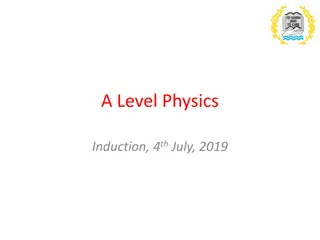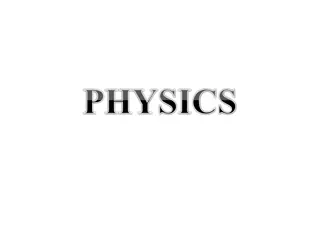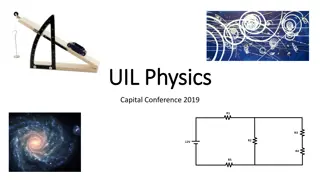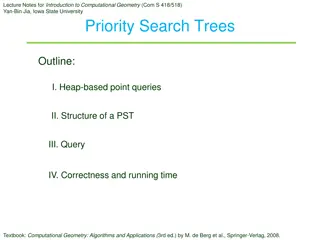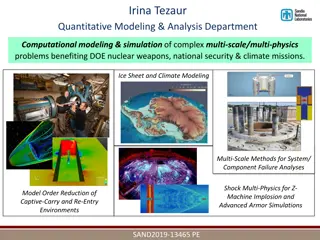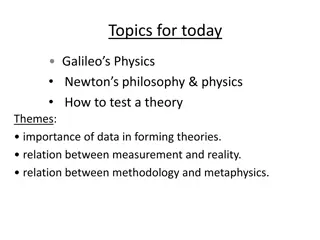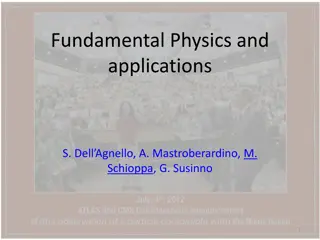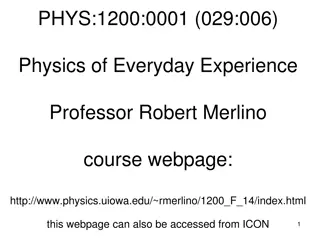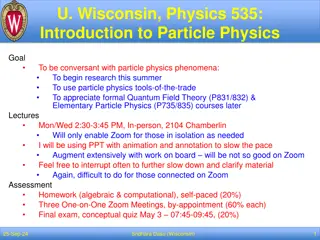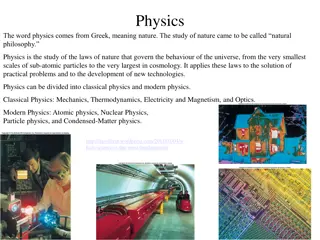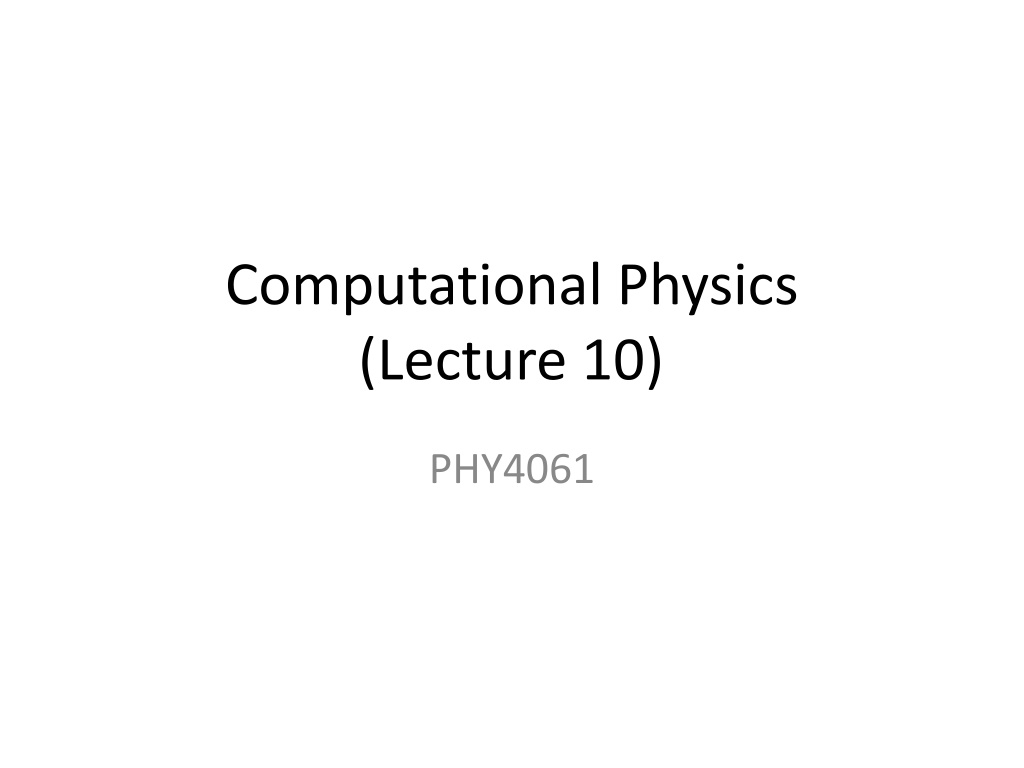
Monte Carlo Simulations in Computational Physics
Explore the history and application of Monte Carlo simulations in computational physics, a powerful numerical technique for solving complex physical systems. Learn about statistical mechanics, Ising models, Heisenberg models, and more. Discover how Monte Carlo simulations have revolutionized the field by providing invaluable insights that are difficult to obtain through analytical approaches.
Download Presentation

Please find below an Image/Link to download the presentation.
The content on the website is provided AS IS for your information and personal use only. It may not be sold, licensed, or shared on other websites without obtaining consent from the author. If you encounter any issues during the download, it is possible that the publisher has removed the file from their server.
You are allowed to download the files provided on this website for personal or commercial use, subject to the condition that they are used lawfully. All files are the property of their respective owners.
The content on the website is provided AS IS for your information and personal use only. It may not be sold, licensed, or shared on other websites without obtaining consent from the author.
E N D
Presentation Transcript
Computational Physics (Lecture 10) PHY4061
Monte Carlo Simulations Statistical mechanics of complex physical systems Difficult to solve by analytical approaches Numerical simulation: indispensable tool MD and MC One of the major numerical techniques developed in the last century for evaluating multidimensional integrals solving integral equations
Brief History of MC The name: the resemblance of the technique of playing and recording your results in a real gambling casino Comte de Buffon s needle problem. Curant: random walk and PDE Fermi in 1930: random sampling to calculate the interaction between neutrons and the concentrated materials, the diffusion and the transport of neutrons. Newmann, Fermi, Ulam and Metropolis in the 40 s and 50 s Rapid progress to solve statistical physics, transport, economical modeling
Theory and application in statistical physics Statistical physics: System with large degrees of freedom A typical problem: Suppose we know the Hamiltonian, calculate the average macroscopic observables. Example: Magnetic system: Ising model Ferromagnetic system Anisotropic along different directions.
Here, on a lattice point I, the spin is either point up or down. Exchange energy is only between neighbors. I is the Zeeman energy However, If the spin direction is in an x-y plane: (xy model)
The spin direction isotropic: (Heisenberg Model) Many more complex models are possible
Statistical Average Average energy and magnetism for one degree of freedom: To any observable A(x), x is a vector in the phase space:
The normalized Boltzmann term: However, we don t know how to calculate the integral. (N degrees of freedom) is the probability density. What is the unit of probability density?
Simple Sampling Equilibrium statistical mechanism: Basic goal: Calculate A(x) according to P(x). Approximate by using a characteristic subset {x1, x2, xN} Randomly select the points X from the phase space uniformly ( simple sampling )
Random Walk transport processes such as diffusion Addition of vectors whose orientation is random can be generated both on lattices and in the continuum, either choose a uniform step length of the walk, or choose the step length from a suitable distribution. desirable if one wishes to consider complicated geometries or boundary conditions of the medium where the diffusion takes place
Straightforward to include competing processes For example, in a reactor, diffusion of neutrons in the moderator competes with loss of neutrons due to nuclear reactions, radiation going to the outside, etc, or gain of neutrons due to fission events. This problem of reactor criticality (and related problems for nuclear weapons!) was the starting point for the first largescale applications of Monte Carlo methods by Fermi, von Neumann, Ulam, and their coworkers!
Self-avoiding walks Widely studied as a simple model for the configurational statistics of polymer chains in good solvents. Considers a square or simple cubic lattice with coordination number z. For a random walk (RW) with N steps ZRW = zNconfigurations many of these random walks intersect themselves and thus would not be self-avoiding. For SAWs, only expects of the order of ZSAW configurations, Where ZSAW N 1zeffN, where N -> . Here > 1 is a characteristic exponent (which is believed to be 43/32 in d =2 dimensions (Nienhuis 1984) while in d =3 dimensions it is only known approximately,1.16
zeffis an effective coordination number (also not known exactly) Obvious that an exact enumeration of all configurations would be possible for rather small N only most questions of interest refer to the behavior for large N. the use of these methods is fairly limited, and is not discussed here further. only concerned with Monte Carlo techniques to estimate quantities such as or zeff or other quantities of interest such as the end-to-end distance of the SAW
For Monte Carlo simulation: Based on a sample of M << Zsaw In the simple sampling generation of SAWs, the M configurations are statistically independent and hence standard error analysis applies. Relative error:
Random variables Type 1: Discrete randome variables : for each value: x1, x2, , xn, , The probability is p1, p2, , pn, . Pi is the probability distribution of Another type of random variable: is continuous, Suppose the probability of in [x, x+ x] is p(x < < x+ x), f(x)is the probability distributional density of , The probability of in [a,b] is given by
Normalized: to discrete random variables to continuous random variables Distribution function:
Two Important theorems: Large number theorem: Suppose 1, 2, , n, is a sequence of independent Random variables with the same distribution, and E( i)=a, to any > 0, we have If n is large enough, the mathematic average converges at the mathematic expected value. This theorem shows that no mater what the random variable distribution is
Central limit theorem: Suppose 1, 2, , n, are a sequence of independent random variables, with the same distribution, E( i)=a, D( i)= 2 exist, The difference of mathematic average and the expected value is normally distributed.
Markov Chain Construct a process, from any micro state of the system, it migrates to a new state. We use xi to show the microstate. If we start from x0, this process will create a sequence of states: x1,x2, , xi, , these states form a chain. Markov process is a process that each state is only related to the previous state. From state r to state s, the transfer probability is w(xr!xs). Markov process creates Markov chain. Also called memoryless chain. To realize normal distribution, we can construct the Markov chain, so that no matter which state we start from, there exists a large number M, after we discard M states, the remainder still satisfies normal distribution.
If w(xr!xs) follows the equilibrium condition: P(x) is the desired distribution. Here it is normal distribution. To prove it, we consider N parallel Markov chains, for a certain step, Nrchains are in rth state, Nschains are in s state. Therefore, the number of the next state that is from r to s Is: From s to r is: The number of the net transfer states is:
If w(xr!xs) follows the equilibrium condition, don t satisfy normal distribution, the Markov process will tend to help it to satisfy the normal distribution. This is a very important result, which indicates that if there are two states that
Back to Ising model Ising model: Ising is a very simple model proposed by Lenz in 20 s. Ising gave the solution and proved that no phase change in 1D Ising model. Onsager found the 2D solution in 1944 and calculated the phase change temperature. C. N. Yang solved the 2D Ising model when the h is very small.
In Ising model, the common interests are energies, Order parameter, fluctuation of energies and fluctuation of order parameters.
One algorithm: Choose a lattice point I, flip the spin. calculate the energy difference H. calculate the transfer probability w. create uniformly distributed random number [0,1] If <w, flip the spin, Otherwise, no change. Calculate the physical properties.
Discusssion The choice of lattice point i: could be different. Two common approaches are: choose the point following the order of lattice index or randomly choose the point. To randomly choose i, we have to make sure that each lattice point is visited for the same number of times. Each Monte Carlo Step (MCS) is that we visit each point once. Thousands or millions of steps will be performed in this calculation. Since there exists only one spin flip between the current state and the previous state, the physical properties are highly correlated. Therefore, we don t have to calculate the physical quantities for each step. Energy difference calculation is time consuming. To Ising model, the energy difference can be only a few values. We can calculate them before the simulation and store them. This is a typical strategy for many MC calculations.
Homework 2 (Due in two weeks after this lecture) Rewrite the F-L program (which is in java) in the lecture notes (also text book) in C/C++ or Fortran and use the revised program to calculate the inversion of a 4x4 matrix (you can just create the 4x4 matrix by yourself).





